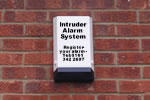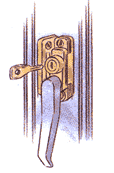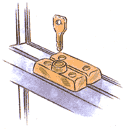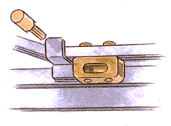Cracking Crime
Outside Your Home
Windows | Doors | Security Lighting | Alarms | Gates and Fences | Gardens, Sheds and Pathways
 Windows
Windows
- Fit key operated window locks to all downstairs windows and to upstairs windows which cannot be seen from the street. Also consider fitting locks to easily accessible windows such as those above a flat roof or near a drainpipe.
- Even the smallest of windows need locks. A thief can get through any gap larger than a human head.
- Remember to remove keys from locked windows and keep them out of sight in a safe place
- Louvre windows are especially vulnerable as the slats can be removed easily. Glue them in place with an epoxy resin or, better still, replace them with fixed glass.
Casement locks make it impossible to open windows without the correct key
The lock shown here locks the opening light secured to the frame. There are more discreet versions which can be embedded into a wooden frame. Other devises stop the window from opening beyond a certain limit
Fanlight locks have a metal bolt to secure the metal arm used to open and close the window
Doors
 Automatic deadlocks lock automatically when the door is closed, but when locked externally with a key, cannot be opened from the inside.
Automatic deadlocks lock automatically when the door is closed, but when locked externally with a key, cannot be opened from the inside.- Chains help you speak with strangers without letting them in. Remember - if in doubt, keep them out.
- Five-lever mortise deadlocks should be fitted about a third of the way up the door. Fit a deadlock with a key, so a thief can't smash a nearby door panel to open the door from the inside and can't use the door as an escape if he gets in through a window.
- Hinges should be sturdy and secured with strong, long screws. For added security fit hinge bolts. They are inexpensive and help to reinforce the hinge side of a door against the use
- Never hang a spare key inside the letterbox, under plant pots or doormats - they are obvious places that a thief will check!
- Consider fitting a letterbox cage which prevents thieves from putting their hand through the letterbox and trying the locks from the inside.
Security Lighting
 There are many types of outside lighting systems, the most popular being the quartz halogen type floodlight connected to a passive infra-red detector (PIR).
There are many types of outside lighting systems, the most popular being the quartz halogen type floodlight connected to a passive infra-red detector (PIR).- Make sure it does not shine into your neighbour's property and that it is positioned high enough to be out of reach of an intruder.
- PIR detectors can be purchased separately to convert an existing outdoor light to a security one.
- Some people prefer external lighting which switches on automatically at dusk and stays on till dawn.
- A photocell darkness detector unit can operate any number or style of light.
- If low wattage economy bulbs are used, these can cost less than 1p per night in electricity.
- Always site lights so that they do not create dark shadowed areas which provide a hiding place for a thief.
Alarms
 There are many burglar alarms on the market ranging from inexpensive DIY kits up to sophisticated systems costing hundreds of pounds.
There are many burglar alarms on the market ranging from inexpensive DIY kits up to sophisticated systems costing hundreds of pounds.- Get specialist advice from the police or your insurance company and quotes from several reputable firms before you decide on the system which suits your needs.
- Make sure the system complies with British Standard 4743 if professionally installed or British Standard 6707 if DIY fitted.
- If you keep precious possessions in the home, it may be worth investing in a small floor or wall safe to keep them secure
Gates and Fences
 Make sure that the fencing and gates at the rear of your home have no weak spots where a thief could get in.
Make sure that the fencing and gates at the rear of your home have no weak spots where a thief could get in.- Low sagging fences and gates without locks are an invitation to the thief.
- An additional deterrent is a thorny hedge or a climber along the boundary.
- Make sure that the front of the house is visible to passers-by and neighbours so that the criminal cannot work unseen.
- A fence with a trellis on top is difficult to climb and does not obscure visibility.
- Front gates should be level with the front of the house so they can be seen.
Gardens, Sheds and Pathways
 As well as growing thorny bushes and climbers along the boundary of gardens, gravel paths as opposed to flags or concrete act as a deterrent to thieves, particularly at night.
As well as growing thorny bushes and climbers along the boundary of gardens, gravel paths as opposed to flags or concrete act as a deterrent to thieves, particularly at night.- Gravel paths running alongside the house walls are very noisy when walked on and give an early warning of intruders.
- Garages often have connecting doors into the rest of the house where a thief can work on the inner door in privacy.
- Sheds often contain valuable tools, some of which can be used for breaking into the house.
- Never leave sheds or garages unlocked.




